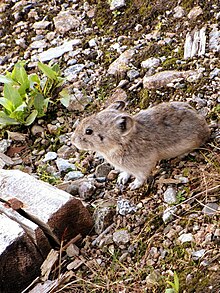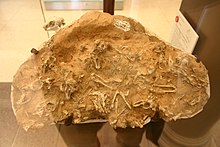Pika Who???
| Pika[2] | |
|---|---|
 | |
| American pika (Ochotona princeps) | |
| Scientific classification | |
| Domain: | Eukaryota |
| Kingdom: | Animalia |
| Phylum: | Chordata |
| Class: | Mammalia |
| Order: | Lagomorpha |
| Family: | Ochotonidae Thomas, 1897 |
| Genus: | Ochotona Link, 1795 |
| Type species | |
| Ochotona daurica | |
| Species | |
See text | |
A pika is a small, mountain-dwelling mammal native to Asia and North America. With short limbs, a very round body, an even coat of fur, and no external tail, they resemble their close relative, the rabbit, but with short, rounded ears.[4] The large-eared pika of the Himalayas and nearby mountains lives at elevations of more than 6,000 m (20,000 ft).
The name "pika" appears to be derived from the Tungus pika,[5] and the scientific name Ochotona is derived from the Mongolian word ogotno, оготно, which means pika.[6] It is used for any member of the Ochotonidae, a family within the order of lagomorphs, the order which also includes the Leporidae (rabbits and hares). They are the smallest animal in the lagomorph group.[8] Only one genus, Ochotona or , is extant within the family, covering 37 species, though many fossil genera are known. Another species, the Sardinian pika, belonging to the separate genus Prolagus, has become extinct within the last 2000 years owing to human activity.
Pikas prefer rocky slopes and graze on a range of plants, primarily grasses, flowers, and young stems. In the autumn they pull hay, soft twigs, and other stores of food under rocks to eat during the long, cold winter.[9] The pika is also known as the whistling hare because of its high-pitched alarm call it gives when alarmed. The two species found in North America are the American pika, found primarily in the mountains of the western United States and far southwestern Canada, and the collared pika of northern British Columbia, the Yukon, western Northwest Territories and Alaska.

Pikas are native to cold climates in Asia and North America. Most species live on rocky mountainsides, where numerous crevices are available for their shelter, although some pikas also construct crude burrows. A few burrowing species are native to open steppe land. In the mountains of Eurasia, pikas often share their burrows with snowfinches, which build their nests there.[10] Changing temperatures have forced some pika populations to restrict their ranges to even higher elevations.[11]

Pikas are small mammals, with short limbs and rounded ears. They are about 15 to 23 cm (5.9 to 9.1 in) in body length and weigh between 120 and 350 g (4.2 and 12.3 oz), depending on species.
These animals are herbivores and feed on a wide variety of plant matter, including forbs, grasses, sedges, shrub twigs, moss and lichens. Easily digestible food is processed in the gastrointestinal tract and expelled as regular feces. But in order to get nutrients out of hard to digest fiber, pika ferment fiber in the cecum and then expel the contents as cecotropes, which are reingested (cecotrophy). The cecotropes are then absorbed in the small intestine to utilize the nutrients.
Collared pikas have been known to store dead birds in their burrows for food during winter and eat the feces of other animals.[12]
As with other lagomorphs, pikas have gnawing incisors and no canines, although they have fewer molars than rabbits. They have a dental formula of: 2.0.3.21.0.2.3 = 26.[13] Another similarity that pikas share with other lagomorphs is that the bottom of their paws are covered with fur and lack paw pads.[14]
Rock-dwelling pikas have small litters of fewer than five young, whilst the burrowing species tend to give birth to more young and to breed more frequently, possibly owing to a greater availability of resources in their native habitats. The young are born altricial (eyes and ears closed, no fur) after a gestation period of between 25 and 30 days.[10]

Pikachu
ReplyDelete